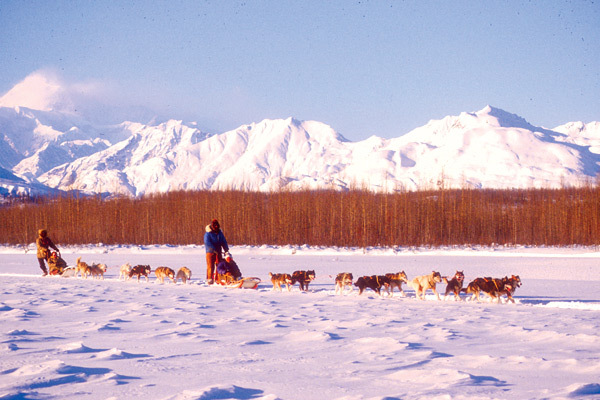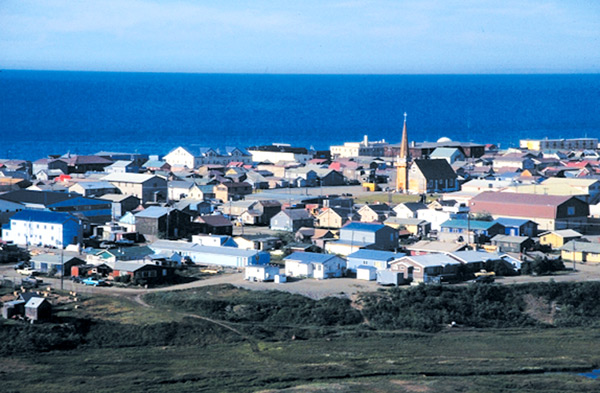On the Seward Peninsula; by air 1.25 hour from Anchorage, 6 hours from Juneau. Commuter flights available to surrounding Norton Sound villages, Kotzebue and Russia’s far east. Population: 3,653. Visitor Information: Nome Convention and Visitors Bureau, 301 Front Street, PO Box 240, Nome, AK 99762; Phone: (907) 443-6555; Email: visit@mynomealaska; Website: wwww.visitnomealaska.com 
For your Alaskan vacation, envision bountiful wildlife, beautiful scenery, the Iditarod dog sled race, genuine Alaskan Native culture, gold rush history, comfortable accommodations, great restaurants, friendly tour guides, unique flightseeing, quality Northern art gift shops and jet service twice daily. That’s Nome!
With federal infrastructure funds recently allocated to create an internationally significant Arctic Deep Draft port in Nome, the design phase has commenced. The city is also expecting multiple cruise ships this season, after two years of Covid-related cancellations.
Three roads lead out of Nome. They each end 70 to 80 miles later and offer an exciting trip through the spectacular scenery of the Seward Peninsula and ample opportunity to view wildlife. Beaver dams are visible, musk-ox graze on the hillsides, domestic reindeer roam the Peninsula, and brown bears are numerous in the mountains where their food sources of squirrels, berries and fish are plentiful.
Every spring, serious birdwatchers arrive in Nome to witness the return of over a hundred and eighty migratory species in brilliant breeding plumage to their nesting grounds. Sport fishing for pike and trophy grayling is popular and salmon fly fishing is superb in the rivers. Fishing guides can supply a trip tailored to each client’s wish.
For two weeks, Nome hosts the “Mardi Gras of the North” during the world famous Iditarod Race, which finishes on Front Street every year in March. Nome is also the halfway point for the world’s longest, toughest snowmachine race, the Iron Dog.
Scenic Drives out of Nome
The Nome-Council Road is optimally a 2-hour and 72-mile drive to the east with sweep¬ing coastal views, ending at the small com¬mu¬ni¬ty of Coun¬cil. The 85-mile Nome-Taylor Road (also called Beam or Kougarok Road) winds north past old min¬ing claims, pop¬u¬lar Salmon Lake, and a side road to his¬toric Pil¬grim Hot Springs. The Nome-Teller Road ends at the namesake Inupiat village located 73 miles northwest of Nome and a mere 108 miles from Russia.
The roads are gravel, only passable in summer, and seriously prone to rugged potholes. Make arrangements in advance to rent a 4-wheel drive vehicle, or guided tours are also available. You can take a closer look at these routes and their many dozens of designated points of interest on the following comprehensive website and see for yourself what adventures await: alaska.org/destination/nome/scenic-drives.
A Birder’s Paradise
The Nome road system provides access to different species along each of the three routes, and you don’t even have to get out of your car to add dozens of new sightings to your life list! You’ll even find quality birding on ponds, wetlands and beaches right in town. If you’re visiting without a car, try the mouth of the Nome River, Cemetery Pond and East End Park. Even through the winter until they scatter in early spring, buntings and other species are plentiful at Nome feeding stations.
The Northwest Campus of University of Alaska Fairbanks in Nome offers extremely affordable, daylong birding field trips for a much lower fee than dedicated birding tours. Usually held on the last weekend in May and first weekend in June, destinations typically include the coast road to Safety Sound and the Kougarok Road over two days. Less than twenty miles from Nome on the Council Road, Safety Sound is an immense migrant trap before breakup, while Council is the only place to see forest dwelling birds. It’s typical to spot between 65 and 80 species on each of these field trips. There are also affordable local guides for hire.
If you’re planning a trip to Nome at the height of birding season, be sure to book lodging well in advance. Visitors can check the Birding Board at the Nome Visitors Center to see what species have been spotted lately, download area guides and checklists, and find social media updates on current sightings.
Museum and Cultural Center
Carrie McLain came to Nome as a young girl in the early 1900s and spent her adult life collecting oral histories, ivory artwork and historical photos from the surrounding area. Opening in 1967, the museum collection was greatly expanded through generous donations of photographs, artifacts and archives. Interactive exhibits feature the landscape, Alaska Native artwork, and the town of Nome from Tent City beginnings to its present-day role as a regional hub. Step inside a miner’s tent, listen to audio recordings in one of Nome’s old telephone booths, and imagine mushing across the tundra as you check out a sled from the 1st Iditarod sled dog race. Relax in the mini-theatre for even more tales from Nome’s early days, and browse the museum’s gift shop for related books, photos and clothing items.
The Katirvik Cultural Center was established in 2016 to realize the vision of regional elders to celebrate, educate and share the rich culture and heritage of the Bering Strait. The center hosts displays that represent themes embodying aspects of the culture of Inupiaq, Central Yupik and St. Lawrence Island peoples.
Norton Sound Seafood
Available both fresh and frozen, Norton Sound Halibut is prized for its delicate, sweet flavor, snow-white color and firm, flaky meat. Sometimes growing to more than eight feet in length and weighing several hundred pounds, these monsters are hauled in one at a time from small skiffs. Wild Coho (silver) and Keta (chum) Salmon are harvested from set nets primarily in eastern Norton Sound. Quick delivery to the Unalakleet facility or specially equipped tender vessels ensures high quality. Coho are the second largest of the salmon species, eager to bite and aggressive once hooked. The firm, red flesh and delicate flavor make them popular for conventional preparation and smoking, while Keta salmon are commonly dried or smoked.
Since 1995, Norton Sound Seafood has created opportunities for the communities and residents of coastal western Alaska, where fishing is a vital subsistence and cultural practice, providing an important commercial opportunity in an area where economic activity is limited. Following a sustainable tradition that has been handed down for generations, the artisanal scale means their seafood is handled with the utmost of care and processed shortly after being caught.
Bering Air
In May 1988, Jim made aviation history when he piloted his Piper Navajo from Nome, across the international dateline and landed to a warm welcome in Provideniya, USSR. To fly into Russia with Bering Air requires a passport, Russian visa and an official entry permission document signed by appropriate Russian/Chukotkan authorities. Visas are issued based on an invitation from a person or corporation, and processing paperwork may take a couple of months. Please note that in the wake of the war in Ukraine, flights into Russia are on hold.
Festivals in Nome
Then there’s the Iditarod Trail Invitational in March when a select group of (fool)hardy souls test them¬selves against Alaska’s win¬ter ele¬ments, traversing the famed trail by moun¬tain bike, skis or on foot. The 5K shoreline Gold Dust Dash offers up a gold nugget to the winner, while the Poor Man’s Beach Gold Pan¬ning Con¬test pits participants against each other to see who can find gold first in their bag of pay dirt.
Summerfest joyfully celebrates youth and art, while shopping for unique, hand-made items is a breeze at Nome’s arts and crafts fairs, the largest of which is held dur¬ing Idi¬tar¬od Week in mid-March. The Nome Arts Council hosts the two-day Alappaa Film Festival, and biannual Open Mic events showcasing music, dance, poetry and storytelling. The Salmonber¬ry Jam Folk Fest is three fun-filled days of local and guest music artists, work¬shops, danc¬ing, crafts and com¬mu¬ni¬ty cook¬out. The Blueberry Festival features arts and crafts, music and delightful blue¬ber¬ry concoctions. Check the Alaska.org website for more information or contact the Nome Visitors Center to determine what’s happening during your visit.
Pilgrim Hot Springs
Uunaqtuq (it is warm or hot) was an important site recognized within the Qawiaraqmiut traditional territory with a long history of use that continues to the present. Honored as a very special place where animals and edible plants were available for subsistence even in winter, the Native people respectfully used the springs in times of need, enjoying healing hot water soaks surrounded by the beauty and spirituality of the area.
During the Nome Gold Rush In the early 1900s, miners were attracted to the site but disregarded the traditional use rules. Claimed in 1905 under the Homestead Act, the area changed ownership twice. A saloon, dance hall and roadhouse were built at the site that burned in 1908. Subsequently, the property was deeded to Judge George Schofield, who in turn deeded it in 1917 to the Provincial of the Jesuit Province of California as a gift for a Catholic mission. The Catholic Diocese of Nome acquired the Pilgrim homestead, and Our Lady of Lourdes Orphanage and 14 other structures were built. A staff of around 20 priests, nuns and other workers ran the facility, which housed about 100 children annually, the first of which primarily orphaned by the 1918 flu epidemic, followed by diphtheria and tuberculosis outbreaks.
Catholic priest Father Bellarmine LaFortune had begun relocating the mission at the village of Mary’s Igloo to Pilgrim Hot Springs when the global Spanish Flu pandemic hit the Nome region. Over half the population of Mary’s Igloo passed away as a result. Numbering between 60 and 70, the deceased were transported by dog team for mass burial in a sandy area near the hot springs that was not frozen ground.
Beginning in 2016, large-scale gardening made possible with geothermal power was reestablished to grow local produce for the region. Many impressive vegetables are harvested to supply villages and for sale weekly in Nome during the extended growing season. In the early 2010s, Alaska Center for Energy and Power drilled geothermal test wells at the site, and Unaatuq is developing projects for energy generation and direct use of geothermal fluids.
Visitors must stay on the road when traveling to the springs as the surrounding lands belong to the Bureau of Land Management, Bering Straits Native Corporation and Mary’s Igloo Native Corporation, unless a permit is acquired from MINC. If arriving by helicopter via Bering Air, or only to visit the gravesites on foot, the permit is not required. To reach the springs, travel to mile 53 on Kougarok Road and turn left onto Pilgrim Road for another 7 miles. A few campsites and small cabins are available to rent, and the property can be reserved for weddings and conferences. For more information, contact Kawerak, Inc. at 500 Seppala Drive, P.O. Box 948, Nome, AK 99762; call 907-443-4278; email pilgrim@kawerak.org or visit pilgrimhotsprings.com.

|
|
| Nome Business Directory |
| Hospitality |
|
Dredge #7 Inn
|
| Travel Services |
|
Nome Convention and Visitors Bureau
|
| General Activities |
|
Alaska Gold and Resort
|



